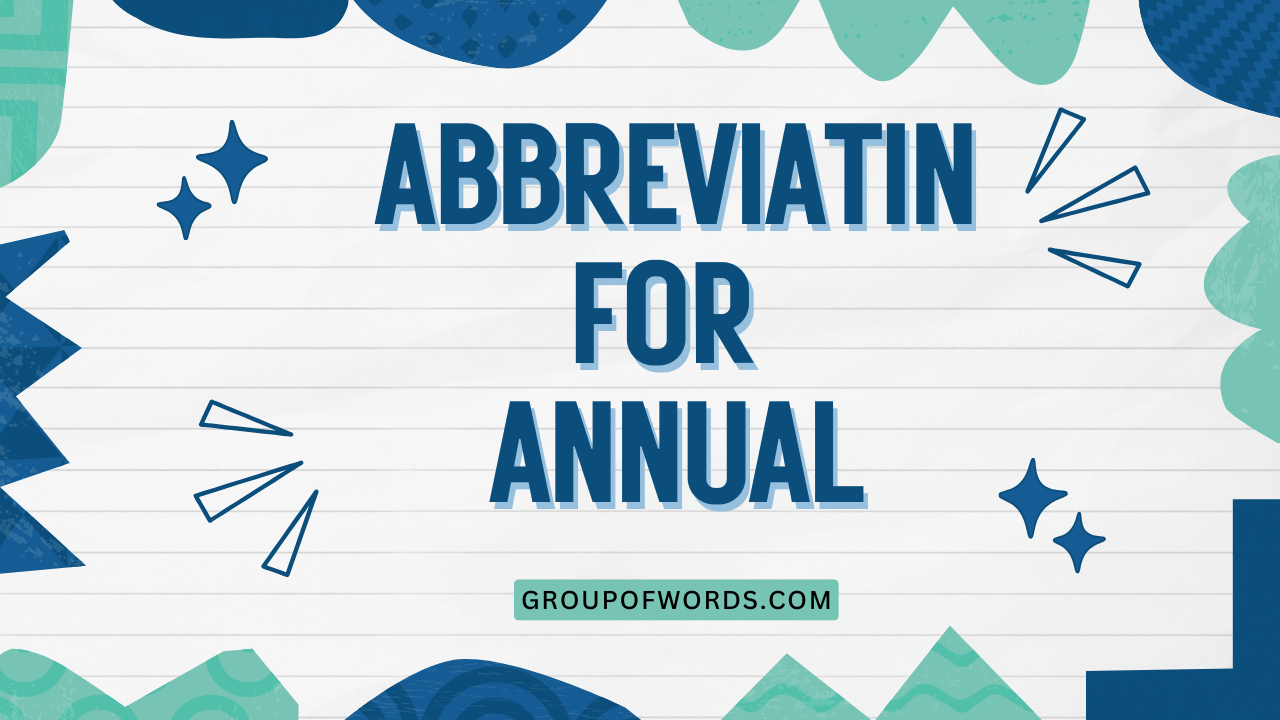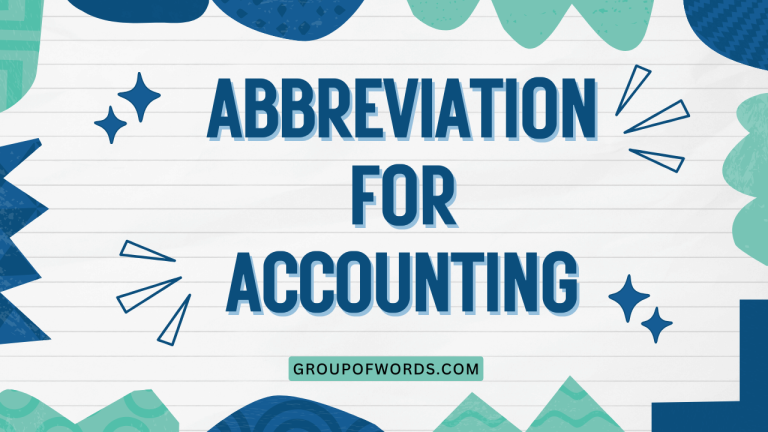Abbreviation for Annual: A Comprehensive Grammar Guide
Understanding abbreviations is crucial for efficient communication in both written and spoken English. The abbreviation for “annual” is a common one, frequently encountered in financial reports, academic publications, and everyday contexts.
This article provides a comprehensive guide to the correct usage, variations, and nuances of this abbreviation, ensuring clarity and precision in your writing. Whether you are a student, a professional, or simply an English enthusiast, mastering this topic will enhance your language skills and prevent potential misunderstandings.
This article is designed to benefit anyone who wants to improve their understanding and use of abbreviations in English, especially those related to time and frequency. It covers everything from the basic definition to advanced usage scenarios, including common mistakes and practical exercises to reinforce your learning.
Table of Contents
- Definition of “Annual” and Its Abbreviation
- Structural Breakdown of the Abbreviation
- Types and Categories of Usage
- Examples of “Ann.” in Various Contexts
- Usage Rules for “Ann.”
- Common Mistakes to Avoid
- Practice Exercises
- Advanced Topics: Formal vs. Informal Usage
- Frequently Asked Questions
- Conclusion
Definition of “Annual” and Its Abbreviation
The word “annual” refers to something that occurs once a year or is calculated over a period of one year. It describes events, publications, reports, or processes that are repeated yearly.
The abbreviation for “annual” is typically “ann.”
Classification: “Annual” is an adjective that modifies nouns to indicate yearly occurrences. Its abbreviation functions similarly, providing a concise way to represent the full word.
Function: The abbreviation “ann.” is used to save space and time in writing. It is particularly common in tables, charts, financial documents, and academic papers where brevity is valued.
Contexts: You’ll find “ann.” used in various contexts, including:
- Financial reports (e.g., “Ann. Revenue”)
- Academic journals (e.g., “Ann. Review of Psychology”)
- Event schedules (e.g., “Ann. Conference”)
- Statistical data (e.g., “Ann. Growth Rate”)
Structural Breakdown of the Abbreviation
The abbreviation “ann.” is a shortened form of the word “annual.” It is created by taking the first three letters of the word and adding a period at the end. The period indicates that it is an abbreviation.
Formation: The abbreviation follows a simple pattern: the first few letters of the word followed by a period. This is a common method for creating abbreviations in English.
Punctuation: The period at the end of “ann.” is essential. It distinguishes the abbreviation from other words and signals that it is not the complete word “annual.”
Capitalization: The abbreviation “ann.” is typically lowercase unless it begins a sentence or is part of a title where capitalization rules apply.
Types and Categories of Usage
While the abbreviation “ann.” is relatively straightforward, its usage can vary slightly depending on the context. Here are some common categories:
Financial Context
In financial reports and documents, “ann.” is frequently used to denote annual figures, such as annual revenue, annual profit, or annual growth rate.
Academic Context
Academic journals and publications often use “ann.” in titles or descriptions of annual reviews or reports.
Event Scheduling
“Ann.” can be used in event schedules to indicate that an event occurs annually, such as an annual conference or an annual meeting.
Statistical Data
Statistical reports and analyses often use “ann.” to represent annual data points, such as annual inflation rate or annual unemployment rate.
General Usage
In general writing, “ann.” can be used to abbreviate “annual” when space is limited or when the context is clear.
Examples of “Ann.” in Various Contexts
The following tables provide examples of how “ann.” is used in different contexts. Each example illustrates the proper usage of the abbreviation and its meaning within the given sentence or phrase.
Financial Reports
The following table shows examples of ‘ann.’ in the context of financial reports.
| Context | Example |
|---|---|
| Revenue | The company reported an ann. revenue of $10 million. |
| Profit | Ann. profit increased by 15% compared to last year. |
| Growth Rate | The ann. growth rate is projected to be 5%. |
| Report | The Ann. Financial Report will be released next month. |
| Expenses | Ann. expenses were carefully managed to maximize profitability. |
| Budget | The ann. budget was approved by the board of directors. |
| Earnings | Ann. earnings per share reached a new high. |
| Loss | The company experienced an ann. loss due to market fluctuations. |
| Statement | The Ann. Income Statement provides a detailed overview of the company’s financial performance. |
| Review | The Ann. Review of the company’s financial health is conducted by an independent auditor. |
| Dividend | The ann. dividend payout was increased to $0.50 per share. |
| Investment | The ann. investment in research and development is crucial for innovation. |
| Return | The ann. return on investment exceeded expectations. |
| Cost | The ann. cost of operations was reduced through efficiency improvements. |
| Sales | Ann. sales figures showed a significant increase in the fourth quarter. |
| Projection | The ann. projection for revenue growth is optimistic. |
| Performance | The ann. performance review highlighted key areas for improvement. |
| Report | The Ann. Performance Report is available on the company website. |
| Meeting | The Ann. Shareholders Meeting will be held in June. |
| Audit | The Ann. Audit confirmed the accuracy of the financial statements. |
| Summary | The Ann. Financial Summary provides a concise overview of the company’s performance. |
| Accounting | The Ann. Accounting practices comply with international standards. |
| Planning | The Ann. Planning process involves setting strategic goals for the coming year. |
| Analysis | The Ann. Analysis of market trends informs investment decisions. |
Academic Publications
The following table shows examples of ‘ann.’ in the context of academic publications.
| Context | Example |
|---|---|
| Review | Read the Ann. Review of Psychology for the latest research. |
| Journal | The article was published in the Ann. Journal of Sociology. |
| Report | The Ann. Research Report summarizes the findings of the study. |
| Studies | Ann. Studies in Linguistics offers a comprehensive overview of the field. |
| Conference | The Ann. Conference on Climate Change will be held in Paris. |
| Symposium | The Ann. Symposium on Artificial Intelligence attracts leading experts. |
| Proceedings | The Ann. Proceedings of the conference are available online. |
| Survey | The Ann. Survey of student satisfaction provides valuable feedback. |
| Lecture | The Ann. Lecture Series features distinguished scholars. |
| Publication | The Ann. Publication of research papers is a key indicator of academic productivity. |
| Meeting | The Ann. Meeting of the academic society will take place in December. |
| Forum | The Ann. Forum on Education Reform brings together policymakers and educators. |
| Seminar | The Ann. Seminar on Economic Development is open to the public. |
| Workshop | The Ann. Workshop on Data Analysis provides hands-on training. |
| Colloquium | The Ann. Colloquium on Literature and Culture explores contemporary issues. |
| Edition | The Ann. Edition of the textbook has been updated with new content. |
| Volume | The Ann. Volume of collected essays covers a wide range of topics. |
| Index | The Ann. Index of research publications is a valuable resource for scholars. |
| Report | The Ann. Progress Report outlines the achievements and challenges of the research project. |
| Review | The Ann. Literature Review provides a critical analysis of existing research. |
| Debate | The Ann. Debate on ethical issues in science sparks lively discussion. |
| Presentation | The Ann. Presentation of research findings is a highlight of the conference. |
| Exhibition | The Ann. Exhibition of student artwork showcases creative talent. |
| Competition | The Ann. Competition for young scientists encourages innovation. |
| Awards | The Ann. Awards ceremony recognizes outstanding achievements in academia. |
Event Schedules
The following table shows examples of ‘ann.’ in the context of event schedules.
| Context | Example |
|---|---|
| Conference | The Ann. Conference will be held in New York this year. |
| Meeting | The Ann. General Meeting is scheduled for next week. |
| Festival | The Ann. Music Festival attracts thousands of visitors. |
| Fair | The Ann. Book Fair is a popular event for book lovers. |
| Celebration | The Ann. Independence Day Celebration includes a parade and fireworks. |
| Gala | The Ann. Charity Gala raises funds for local charities. |
| Summit | The Ann. Tech Summit brings together industry leaders and innovators. |
| Trade Show | The Ann. Trade Show showcases the latest products and services. |
| Exposition | The Ann. Exposition of arts and crafts features local artisans. |
| Retreat | The Ann. Company Retreat promotes team building and strategic planning. |
| Ceremony | The Ann. Awards Ceremony recognizes outstanding achievements in the community. |
| Banquet | The Ann. Fundraising Banquet supports the organization’s mission. |
| Symposium | The Ann. Research Symposium presents cutting-edge research findings. |
| Workshop | The Ann. Training Workshop provides professional development opportunities. |
| Seminar | The Ann. Business Seminar offers insights into current market trends. |
| Lecture | The Ann. Guest Lecture features a renowned speaker on a relevant topic. |
| Presentation | The Ann. Project Presentation showcases the team’s accomplishments. |
| Forum | The Ann. Public Forum addresses important community issues. |
| Assembly | The Ann. School Assembly celebrates student achievements. |
| Reunion | The Ann. Class Reunion brings alumni together to reconnect. |
| Convention | The Ann. Convention of educators will be held in Chicago. |
| Exhibition | The Ann. Art Exhibition features works by local artists. |
| Film Fest | The Ann. Film Fest showcases independent films from around the world. |
| Sports Day | The Ann. Sports Day promotes physical activity and sportsmanship. |
Statistical Data
The following table shows examples of ‘ann.’ in the context of statistical data.
| Context | Example |
|---|---|
| Inflation Rate | The ann. inflation rate is currently at 2%. |
| Unemployment Rate | The ann. unemployment rate decreased slightly this year. |
| Growth Rate | The ann. GDP growth rate is projected to be 3%. |
| Population Growth | The ann. population growth is slowing down. |
| Sales Figures | The ann. sales figures exceeded expectations. |
| Revenue Statistics | The ann. revenue statistics show a positive trend. |
| Export Volume | The ann. export volume increased significantly. |
| Import Volume | The ann. import volume remained stable. |
| Production Output | The ann. production output reached a record high. |
| Consumption Rate | The ann. consumption rate is a key indicator of economic health. |
| Investment Rate | The ann. investment rate is crucial for long-term growth. |
| Savings Rate | The ann. savings rate affects the availability of capital. |
| Mortality Rate | The ann. mortality rate is a measure of public health. |
| Birth Rate | The ann. birth rate is an important demographic indicator. |
| Crime Rate | The ann. crime rate is a concern for public safety. |
| Accident Rate | The ann. accident rate is a focus of traffic safety initiatives. |
| Literacy Rate | The ann. literacy rate reflects the level of education. |
| Poverty Rate | The ann. poverty rate is a measure of social inequality. |
| Energy Consumption | The ann. energy consumption is a factor in environmental sustainability. |
| Water Usage | The ann. water usage is a concern in arid regions. |
| Carbon Emissions | The ann. carbon emissions contribute to climate change. |
| Recycling Rate | The ann. recycling rate is a measure of environmental responsibility. |
| Waste Generation | The ann. waste generation is a challenge for urban areas. |
| Agricultural Yield | The ann. agricultural yield affects food security. |
Usage Rules for “Ann.”
Using “ann.” correctly involves following a few key rules:
- Always use a period: The period is essential to indicate that it is an abbreviation.
- Capitalization: Capitalize “Ann.” only when it starts a sentence or is part of a title that requires capitalization.
- Context: Ensure the context is clear. The abbreviation should be easily understood by the reader.
- Consistency: Be consistent in your usage. If you use “ann.” in one place, use it throughout the document for consistency.
Exceptions: There are few exceptions to these rules, but it’s important to note that in very informal writing, the period might be omitted, though this is generally discouraged in formal or professional contexts.
Common Mistakes to Avoid
Here are some common mistakes to avoid when using the abbreviation “ann.”:
| Mistake | Correct | Explanation |
|---|---|---|
| Omitting the period (ann) | ann. | The period indicates that it is an abbreviation. |
| Incorrect capitalization (Ann) in the middle of a sentence | ann. | Use lowercase unless it starts a sentence or is part of a title that requires capitalization. |
| Using “ann” without a clear context | annual | If the context is unclear, use the full word “annual.” |
| Using “an.” instead of “ann.” | ann. | The correct abbreviation is “ann.” |
Practice Exercises
Test your understanding of the abbreviation “ann.” with these practice exercises. Fill in the blanks with the correct abbreviation or the full word “annual” depending on the context.
| Question | Answer |
|---|---|
| The company reported an ____ growth rate of 10%. | ann. |
| The ____ conference will be held in London. | annual |
| The ____ report is due next month. | ann. |
| We conduct an ____ review of our finances. | annual |
| The ____ general meeting is scheduled for Friday. | ann. |
| The ____ budget was approved by the board. | ann. |
| The ____ revenue exceeded expectations. | ann. |
| They publish an ____ review of literature. | annual |
| The ____ survey provides valuable insights. | ann. |
| The ____ cost of maintenance is increasing. | ann. |
| The ____ trade show will feature new products. | annual |
| The ____ meeting is an important event for shareholders. | annual |
| The ____ dividend was announced. | ann. |
| The ____ report summarizes the findings. | ann. |
Advanced Topics: Formal vs. Informal Usage
While “ann.” is a standard abbreviation, its use can vary based on the formality of the writing. In formal documents, such as academic papers or official reports, it is generally acceptable to use “ann.” to save space and maintain a professional tone.
However, in very informal writing, such as personal emails or casual blog posts, it may be more appropriate to use the full word “annual” for clarity and to avoid sounding overly technical.
Formal Usage: In formal contexts, “ann.” is often used in tables, charts, and figures to label data points or categories. It is also common in the titles of academic journals and reports.
Informal Usage: In informal contexts, “annual” is often preferred to avoid sounding overly formal or technical. This is especially true when writing for a general audience who may not be familiar with the abbreviation.
Frequently Asked Questions
- What does “ann.” stand for?
“Ann.” is the abbreviation for “annual,” which means occurring once a year or calculated over a period of one year.
- Is it necessary to use a period after “ann.”?
Yes, the period is essential. It indicates that “ann.” is an abbreviation and not a complete word. Omitting the period is a common mistake that should be avoided.
- When should I capitalize “ann.”?
You should capitalize “Ann.” only when it starts a sentence or is part of a title where capitalization rules apply. Otherwise, use lowercase “ann.”
- Is it acceptable to use “ann.” in all types of writing?
While “ann.” is widely accepted, it’s best to consider your audience and the context of your writing. In formal documents, it’s perfectly acceptable. In informal writing, using the full word “annual” may be more appropriate for clarity.
- Can I use “ann” without a period in informal writing?
While it might be seen in very informal contexts, it is generally discouraged. Always use “ann.” with a period for clarity and correctness.
- Are there other abbreviations for “annual”?
No, “ann.” is the standard and most widely recognized abbreviation for “annual.” There are no other common alternatives.
- How can I remember to use “ann.” correctly?
Practice using “ann.” in different contexts and review the usage rules regularly. Pay attention to how it is used in professional documents and academic publications.
- Is “ann.” used in spoken English?
While “ann.” is primarily used in written English, you might occasionally hear it in formal presentations or discussions where brevity is important. However, it’s more common to say “annual” in spoken language.
- Why is it important to use abbreviations correctly?
Using abbreviations correctly ensures clarity and professionalism in your writing. Incorrect usage can lead to misunderstandings and may damage your credibility. Proper use of abbreviations demonstrates attention to detail and respect for language conventions.
- What are some other common abbreviations used in financial reports?
Some other common abbreviations used in financial reports include “FY” for fiscal year, “Q” for quarter (e.g., Q1, Q2), “EPS” for earnings per share, and “ROI” for return on investment. Understanding these abbreviations can help you interpret financial documents more effectively.
Conclusion
Mastering the abbreviation “ann.” is a simple yet valuable skill that enhances your ability to communicate effectively in English. By understanding its definition, structural breakdown, usage rules, and common mistakes, you can confidently use it in various contexts, from financial reports to academic publications.
Remember to always use a period, consider the formality of your writing, and practice using it regularly to reinforce your learning.
By following the guidelines and examples provided in this article, you can avoid common errors and ensure that your writing is clear, concise, and professional. Keep practicing and refining your skills, and you’ll become a more confident and effective communicator.






